What is a compost toilet?
A compost toilet stores and treats sewage within, recycling nutrients into fertiliser that can be used on the garden. Here at Hilltop we offer a variety of composting toilet designs, but keeping urine separate is the key to successful composting, otherwise it can become anaerobic and smelly. This separation process helps to create a more hygienic and odour free experience along with a large reduction in waste storage volume.
For areas or sites with no or limited water supplies a compost toilet is a green and sustainable option to consider offering a fully functional waterless toilet system. A number of our off grid builds also offer water catchment systems for hand basins if preferred to the standard alcohol gel sanitation.
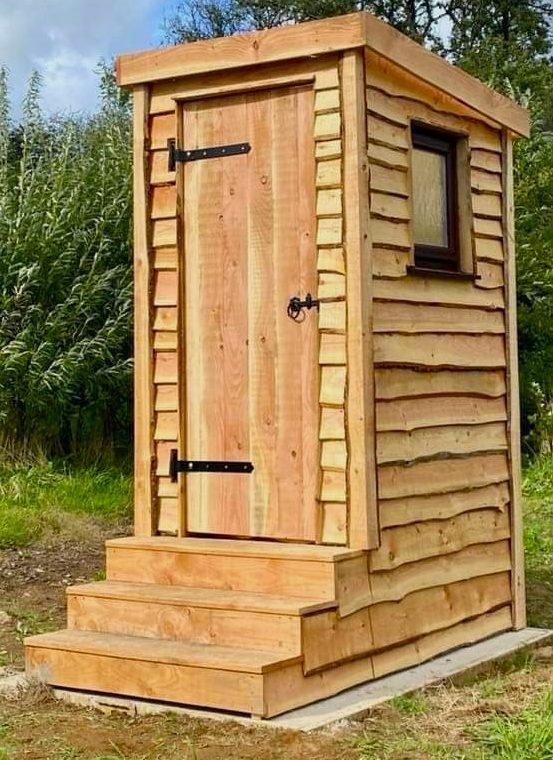
The composting process
Our toilets are designed so that excreta falls directly into a composting chamber enclosed underneath the toilet. Naturally occurring bacteria, worms, fungi and other organisms will thrive on this organic matter and break it down into humus. The use of an appropriate ‘soak’ material is advised, as is controlling moisture through our urine separators and additional ventilation options.
Human excreta can often contain pathogenic bacteria, viruses and protozoa, and in most cases dangerous to human health. Composting works to kill these human pathogens, along with an odour free compost. The final result is a product with excellent soil conditioner properties ideal for use on ornamental shrubs and flowers in the garden.

The compost Ingredients
To create compost in the smallest time frame you will need these four ingredients :
Some Nitrogen, some carbon, some air and some moisture
On a lighter note composting will happen over time without your help, and an ideal ratio is not necessary therefore do not stress or delve to deep into the optimum ratios, let nature ,magically do its thing.
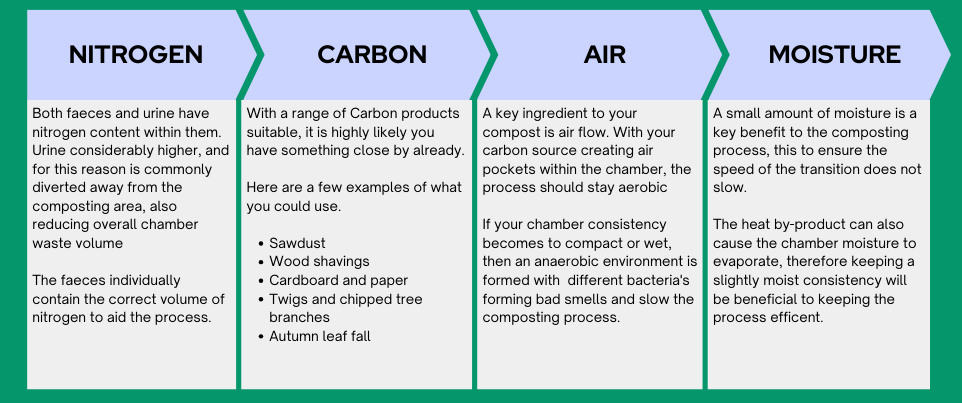
Carbon / Soak Sources
In most cases you will add a ‘soak’ material to the composting chamber to help the decomposition process. Conventional wisdom is to add soak after every toilet use as an alternative to the flushing, but in fact not essential and only a small amount is required also keeping the overall chamber volume as small as possible.
There are many recommendations circulating on the best performing soak materials to use to help aid the decomposition process.
Information and recommended sources of carbon that you might want to use.
> Sawdust – such as from chainsawing . Never from wood treated with a preservative or ‘manufactured’ woods like MDF, OSB or Plywood.
> Wood shavings – sold as pet or animal bedding. Available in a relatively low cost quantity from equine and agricultural merchants.
> Cardboard and paper – especially corrugated cardboard. Only small amounts though and torn into small pieces and best mixed with other carbon sources.
In a publicly used composting toilet there is a tendency of unfamiliarity with the operation techniques and an overuse and addition of soak is common. This effecting the composting process whilst also causing a commonly soak scattered cubicle and sawdust scattered about. After some experience we recommend a daily or weekly addition of soak may be a better solution to a more efficient and tidier composting system and cubicle.
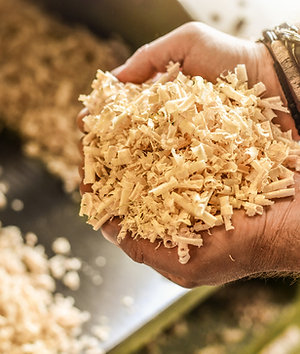
Our separation System
For an odour-free composting experience in the UK climate, it is essential to use our simple separation system which is made by ourselves and supplied with each of our toilets. This plumb free, water free diverter helps to take away urine to its holding tank or soak away, allowing a dry and healthy environment for the composting process to take place efficiently.
The separator itself sits below the toilet seat neatly with no intrusion above. With some simple instructions (supplied with each toilet) how to use appropriately can be quickly educated.
Separators only work while sitting, therefore all male users are required to sit to use the toilets….. and because this can be a tough rule to enforce we also offer the option of waterless urinals with many of our designs, thus allowing a more efficient system and less likelihood of urine contaminated compost and bad odours.
Our chamber system most commonly sits below the toilet out of sight, but each toilet from our range can be piped to a urine storage facility of varying capacity hand handled accordingly due to its sterile state, or into a pre constructed soak away adequate to facilitate the waste liquids. Feel free to contact us about our ground works and install service for both toilets and showers.
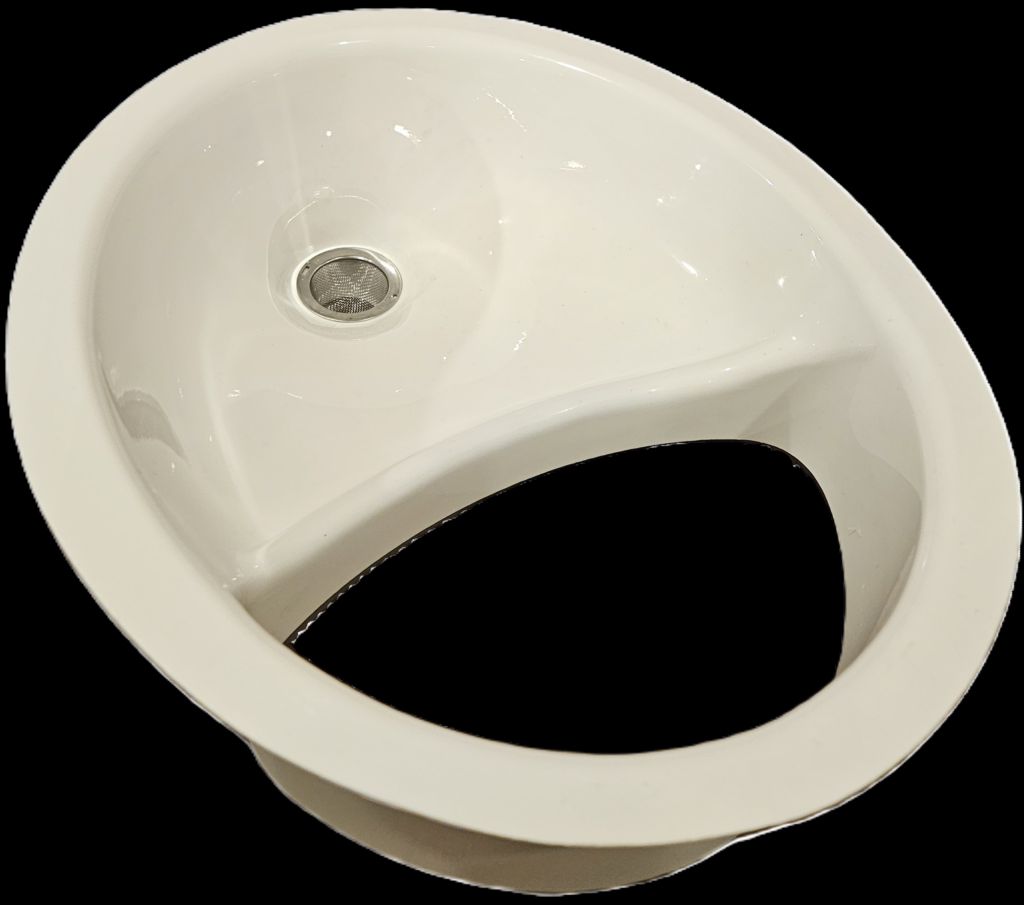
Starting a new compost chamber
Here at Hilltop we design our toilets around both half size or full size wheelie bins, offering maximum volume with manageable solutions for your waste, along with easy of storage for the composting process to take place.
With each new storage chamber / wheelie bin it’s a good idea to start by adding a spadeful of compost and even perhaps some additional brandling worms (the common UK red and brown garden worm) to help give the compost process a head start.
When the time arrives to switch chambers around every 12 months or when full, you can ‘seed’ a new chamber using a small amount of the compost from the chamber being left to rest.
If your waste does not seem to be decomposing well, you can add a shovel of well-composted garden compost, or a few brandling worms thus to help speed up the process.

Twin chamber composting
For a highly efficient approach in our UK climate,it is advised to alternate annually between two separate chambers.
The main active chamber fills with excreta and soak over the course of the first 12 months or (when it becomes full whichever first).
After this period the chamber is removed and replaced with the second leaving the contents of the original chamber to fully compost to a usable substance. To follow this cycle the chamber is replaced under the toilet while the other matures. This batch processing means there is no contamination of mature compost with fresh feces giving an efficient scheduling process.
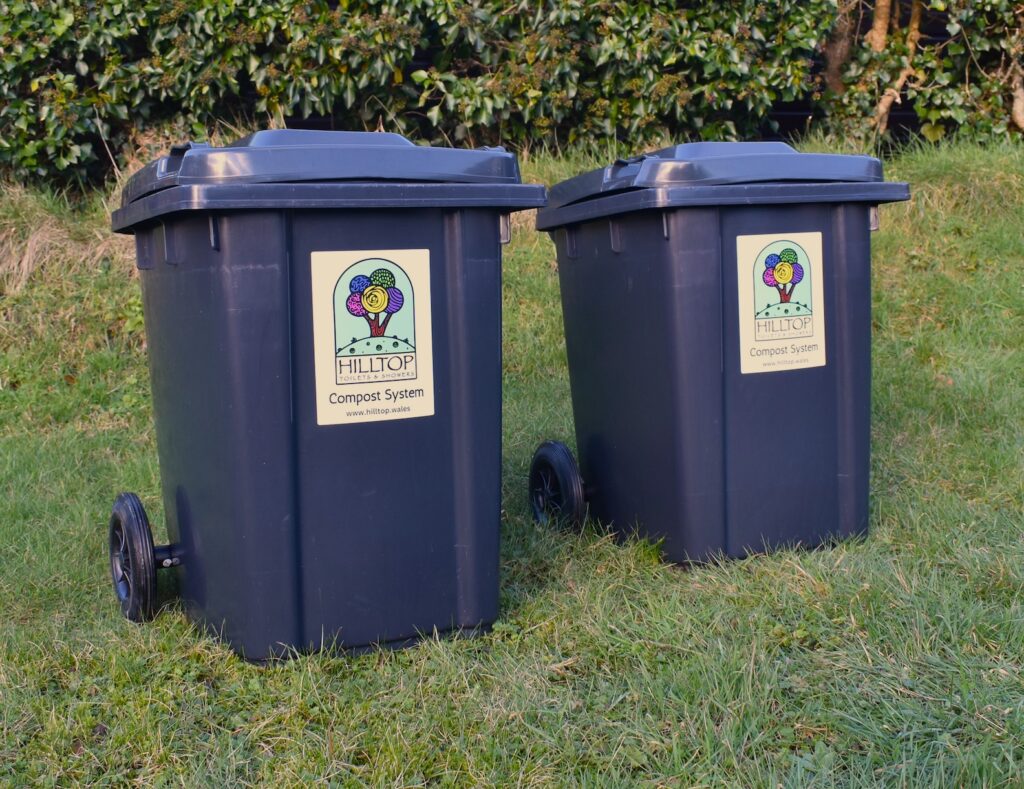
Venting the Chamber
During the composting process ventilation is an essential addition for effective composting and for preventing bad smells.
At Hilltop we have a variety of ventilation options to help draw air across the top of the chamber to promote the compost process and take away if any the unwanted odors.
A small amount of Passive ventilation is fairly natural in our designs or alternatively we offer both wind powered and also low wattage fan systems to aid the air flow and efficiency of the process.



